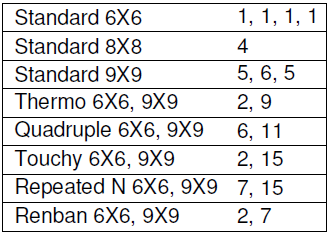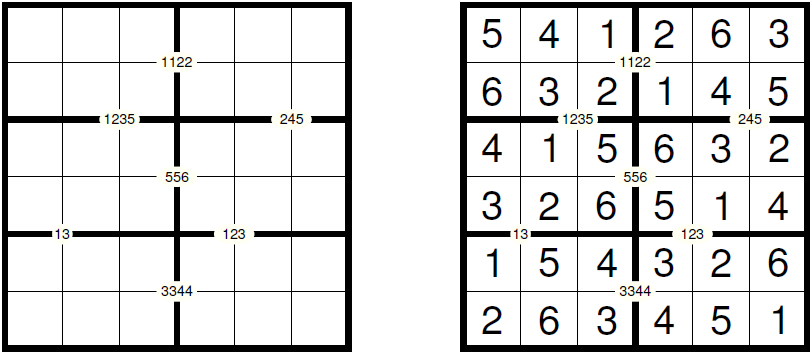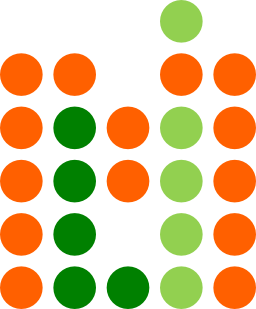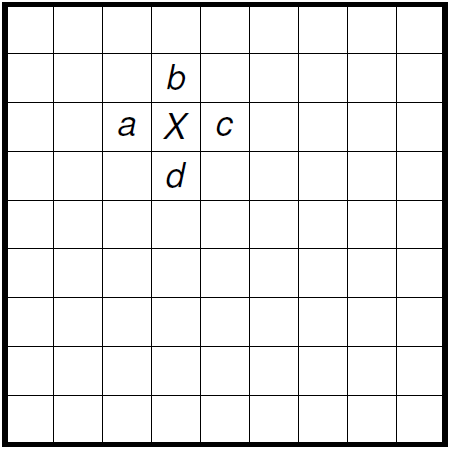Posts: 3574






Country : India
Administrator posted @ 2015-09-07 9:41 PM

Link for rules and other details about Sudoku Mahabharat : http://logicmastersindia.com/SM/2015-16.asp
Instructions for Neighbours - http://logicmastersindia.com/SM/201509/
 @ 2015-09-08 9:49 AM (#19261 - in reply to #19255) (#19261) Top
@ 2015-09-08 9:49 AM (#19261 - in reply to #19255) (#19261) TopPosts: 3574






Country : India
Administrator posted @ 2015-09-08 9:49 AM
Neighbours
Instruction Booklet for Neighbours published.Link : http://logicmastersindia.com/SM/201509/
 @ 2015-09-08 11:11 AM (#19263 - in reply to #19255) (#19263) Top
@ 2015-09-08 11:11 AM (#19263 - in reply to #19255) (#19263) TopPosts: 1909






Country : India
prasanna16391 posted @ 2015-09-08 11:11 AM
Touchy and Renban are repeated from last year's Sudoku Mahabharat Neighbours round - http://logicmastersindia.com/lmitests/?test=SM201502
Thermo is basically 'Inequality in series', so that is technically a repeat too. Either way, Thermo Sudoku is very common and a search of any blogs on the LMI links page should get some results - http://logicmastersindia.com/home/?g=links . Renban and Quadruple should also be somewhat common on blogs and sites.
Quadruple is a repeat from last year, but from the Standard variations round. http://logicmastersindia.com/lmitests/?test=SM201409
Repeated Neighbours has appeared in Sudoku Grand Prix Indian round in 2013 and 2014. There is a 'pairs' logic to this variant which really helps solve it. It a mix of Neighbours & Converse so could have been on either round. One hint is to compare it to Untouch Sudoku.
http://logicmastersindia.com/lmitests/?test=M201302S
http://gp.worldpuzzle.org/content/wpf-sudoku-gp7
If you are feeling really adventurous, then try this one from my blog, but be warned, it took even some of the world's best solvers upwards of 20 minutes. The competition one will definitely be much easier :)
https://prasannaseshadri.wordpress.com/2013/07/23/puzzle-no-415-repe...
 @ 2015-09-08 12:39 PM (#19270 - in reply to #19255) (#19270) Top
@ 2015-09-08 12:39 PM (#19270 - in reply to #19255) (#19270) TopPosts: 27

Country : India
mihiryadav posted @ 2015-09-08 12:39 PM
 @ 2015-09-08 1:11 PM (#19271 - in reply to #19270) (#19271) Top
@ 2015-09-08 1:11 PM (#19271 - in reply to #19270) (#19271) TopPosts: 3574






Country : India
Administrator posted @ 2015-09-08 1:11 PM
In repeated neighbours....can there be two pairs of repeating neighbours?...and can a neighbour repeat thrice?
Neighbours in this puzzle refer to Orthogonal (i.e. sharing an edge) neighbours. So it can't repeat thrice. But there can be two pairs of repeating neighbours.
 @ 2015-09-11 1:07 PM (#19295 - in reply to #19255) (#19295) Top
@ 2015-09-11 1:07 PM (#19295 - in reply to #19255) (#19295) TopPosts: 3574






Country : India
Administrator posted @ 2015-09-11 1:07 PM
Points Table
Instruction Booklet is re-uploaded with points table. Here it is for your quick reference.
 @ 2015-09-11 1:37 PM (#19296 - in reply to #19255) (#19296) Top
@ 2015-09-11 1:37 PM (#19296 - in reply to #19255) (#19296) TopPosts: 27

Country : India
mihiryadav posted @ 2015-09-11 1:37 PM
 @ 2015-09-11 2:32 PM (#19297 - in reply to #19296) (#19297) Top
@ 2015-09-11 2:32 PM (#19297 - in reply to #19296) (#19297) TopPosts: 1909






Country : India
prasanna16391 posted @ 2015-09-11 2:32 PM
How to proceed ahead?
Not sure what this is in reference to. Can you specify? You mean Repeated Neighbours?
 @ 2015-09-11 4:04 PM (#19298 - in reply to #19255) (#19298) Top
@ 2015-09-11 4:04 PM (#19298 - in reply to #19255) (#19298) TopPosts: 3574






Country : India
Administrator posted @ 2015-09-11 4:04 PM
Quadruple Sudoku
Minor change in rules of "Quadruple Sudoku"Apply standard Sudoku rules.
Additionally, the digits given at the corner must appear in the 4 adjoining cells. If any digit is given twice, it must appear twice.
See example below:

Instructions booklet is updated with this rule.
 @ 2015-09-11 5:37 PM (#19299 - in reply to #19255) (#19299) Top
@ 2015-09-11 5:37 PM (#19299 - in reply to #19255) (#19299) TopPosts: 24

Country : India
lrani posted @ 2015-09-11 5:37 PM
 @ 2015-09-11 5:37 PM (#19300 - in reply to #19255) (#19300) Top
@ 2015-09-11 5:37 PM (#19300 - in reply to #19255) (#19300) TopPosts: 114

Country : India
devarajand posted @ 2015-09-11 5:37 PM
 @ 2015-09-11 5:39 PM (#19301 - in reply to #19299) (#19301) Top
@ 2015-09-11 5:39 PM (#19301 - in reply to #19299) (#19301) Top
Posts: 1869








Country : India
debmohanty posted @ 2015-09-11 5:39 PM
There is no doubt on the updated rule. I was thinking that in a Quadruple sudoku always 4 numbers will be given as clues to be filled in the 4 adjoining cells. In the example which is updated above less than 4 nos are given as clues to be filled in the adjoining cells. Pls confirm.
Yes, the new example having less than 4 numbers is intentionally given. The Sudoku(s) in the contest will have clues like this.
 @ 2015-09-11 5:45 PM (#19302 - in reply to #19300) (#19302) Top
@ 2015-09-11 5:45 PM (#19302 - in reply to #19300) (#19302) Top
Posts: 1869








Country : India
debmohanty posted @ 2015-09-11 5:45 PM
Pl detail the rules of Repeated Neighbours and updated rule of Quadruple.
Repeated Neighbours :
Note that here Neighbours means "orthogonal neighbours" i.e. cells sharing an edge. So, one cell can have maximum 4 orthogonal neighbours.
Among those 4 neighbouring cells, if any two cells have same digit, then the original cell will be shaded.
Converse rule applies i.e. a) all possible shaded cells are marked. b) a white cell must have different digits in the 4 neighbouring cells.
Quadruple :
Note sure how to elaborate this. The rule is pretty clear and the new example shows all possible cases.
If any particular sentence is not clear in the rule, please highlight that and we will re-word, if possible.
 @ 2015-09-11 5:48 PM (#19303 - in reply to #19255) (#19303) Top
@ 2015-09-11 5:48 PM (#19303 - in reply to #19255) (#19303) Top
Posts: 1869








Country : India
debmohanty posted @ 2015-09-11 5:48 PM
The last thing you want to do after you start the timer is to understand the rules :)
 @ 2015-09-11 6:54 PM (#19305 - in reply to #19302) (#19305) Top
@ 2015-09-11 6:54 PM (#19305 - in reply to #19302) (#19305) TopPosts: 3
Country : India
Himanshi posted @ 2015-09-11 6:54 PM
In 6x6 sudoku, the same digits are repeated diagonally in the shaded cells. But in 9x9 sudoku, I find digits repeating diagonally with respect to some white cells, for eg. 9 is repeating in R2C3 & R3C4, 7 is repeating in R6C3 & R7C2 and R3C6 & R4C5 etc and not for shaded cells
Edited by Himanshi 2015-09-11 7:09 PM
 @ 2015-09-11 7:13 PM (#19307 - in reply to #19305) (#19307) Top
@ 2015-09-11 7:13 PM (#19307 - in reply to #19305) (#19307) TopPosts: 1909






Country : India
prasanna16391 posted @ 2015-09-11 7:13 PM
I am really confused with respect to Repeated Neighbours. Can you please elaborate with the help of a diagram as to what does sharing an edge means. ( The way Anti Knight Sudoku is explained)
In 6x6 sudoku, the same digits are repeated diagonally in the shaded cells. But in 9x9 sudoku, I find digits repeating diagonally with respect to some white cells, for eg. 9 is repeating in R2C3 & R3C4, 7 is repeating in R6C3 & R7C2 and R3C6 & R4C5 etc and not for shaded cells
The rule doesn't mean that digits in shaded cells will repeat. The digit in a shaded cell is irrelevant for that cell, it means (at least) two cells around that cell will have repeating digits. So in the 6x6 that is forced to be in a shaded cell but the way to look at it in there is, for R2C3, R2C4 and R3C3 are repeating among the 4 cells around it, so R2C3 is shaded. Since R2C3 and R3C4 are also repeating, R2C4 and R3C3 are shaded because for both of those cells, a digit is repeating in the 4 cells around them.
 @ 2015-09-11 8:19 PM (#19308 - in reply to #19255) (#19308) Top
@ 2015-09-11 8:19 PM (#19308 - in reply to #19255) (#19308) Top
Posts: 1869








Country : India
debmohanty posted @ 2015-09-11 8:19 PM
| Explaining with a diagram. In the image at the right, the cell X has 4 orthogonal neighbours. They are marked as a,b,c,d. As you can see X shares an edge (side) with each of the four. Now the rule of the Sudoku : If the cell X is white, a, b, c & d must be all different. If the cell X is shaded, then there must be some repetition among a,b,c,d (i.e. At least one of a = b or a =d or c = b or c =d must be true) |  |
 @ 2015-09-11 9:31 PM (#19309 - in reply to #19255) (#19309) Top
@ 2015-09-11 9:31 PM (#19309 - in reply to #19255) (#19309) TopPosts: 3
Country : India
Himanshi posted @ 2015-09-11 9:31 PM
Just to confirm " a can never be = c" and " b can never be = d"
 @ 2015-09-11 9:37 PM (#19310 - in reply to #19309) (#19310) Top
@ 2015-09-11 9:37 PM (#19310 - in reply to #19309) (#19310) Top
Posts: 1869








Country : India
debmohanty posted @ 2015-09-11 9:37 PM
Just to confirm " a can never be = c" and " b can never be = d"
 @ 2015-09-11 10:17 PM (#19311 - in reply to #19310) (#19311) Top
@ 2015-09-11 10:17 PM (#19311 - in reply to #19310) (#19311) TopPosts: 3
Country : India
Himanshi posted @ 2015-09-11 10:17 PM
 @ 2015-09-11 11:13 PM (#19312 - in reply to #19255) (#19312) Top
@ 2015-09-11 11:13 PM (#19312 - in reply to #19255) (#19312) TopPosts: 2
Country : India
piyush99 posted @ 2015-09-11 11:13 PM
 @ 2015-09-11 11:23 PM (#19313 - in reply to #19312) (#19313) Top
@ 2015-09-11 11:23 PM (#19313 - in reply to #19312) (#19313) TopPosts: 1909






Country : India
prasanna16391 posted @ 2015-09-11 11:23 PM
I am not able to get a start for the repeated neighbours sudoku (6*6). Can anyone plz help?
See the image above and ask yourself this - if X is shaded, to accommodate any combination of repeating letters, wouldn't you need another shaded cell nearby, considering that white cells cannot have repeating neighbours?
 @ 2015-09-11 11:34 PM (#19314 - in reply to #19255) (#19314) Top
@ 2015-09-11 11:34 PM (#19314 - in reply to #19255) (#19314) TopPosts: 2
Country : India
piyush99 posted @ 2015-09-11 11:34 PM
 @ 2015-09-12 4:18 AM (#19315 - in reply to #19255) (#19315) Top
@ 2015-09-12 4:18 AM (#19315 - in reply to #19255) (#19315) TopPosts: 42


Country : United States
PuzzleScott posted @ 2015-09-12 4:18 AM
 @ 2015-09-12 5:49 AM (#19316 - in reply to #19315) (#19316) Top
@ 2015-09-12 5:49 AM (#19316 - in reply to #19315) (#19316) Top
Posts: 1869








Country : India
debmohanty posted @ 2015-09-12 5:49 AM
In touchy sudoku, is it just clue digits that require a consecutive neighbor? Or is it every digit in the full solution?